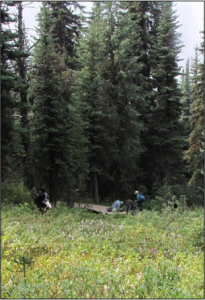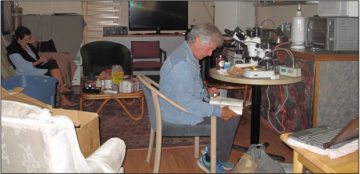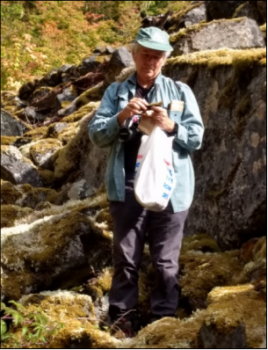Despite being the closest participants, only an hour away from our headquarters for the 8th annual Wilf Schofield Bryoforay at the Slumber Lodge in Hope, BC, my wife and I pulled in minutes before the 7:00 pm kick-off meeting on September 7th. While paying for our room in the office, Olivia Lee, Wilf Schofield’s long-time, essential bryological accomplice, guardian and overseer of the UBC Herbarium/Beaty Museum’s cryptogram collection, popped in and mentioned that she had arrived early and had been scouting out Manning Provincial Park since about 9:00 am. Wow. I quickly paid, dumped my stuff in the room and rushed over to the makeshift meeting area and lab, a large room made smaller by scattered chairs and tables, discards from the motel. Benita and I negotiated the narrow corridor from the door to a small kitchen and lounge area where all the participants were affixed to mismatched chairs and couches placed around the assortment of juices and snacks on a low, nondescript coffee table.
After brief and informal introductions – this was a gathering of bryologists and bryological enthusiasts* after all – Olivia went over the logistics and the areas she had scouted, potential sites for exploration over the coming three days. We hatched a plan for tomorrow’s outing based on Olivia’s logical suggestion that the high-elevation subalpine/alpine trail would be less crowded the first day, a Friday, than it would on the weekend.
*We had among us the esteemed lichenologist Dr. Janet Marsh and others who, while for the most part properly
conducted themselves behind a veil of bryological wonderment, sometimes carelessly fell under the spell of other
organisms including vascular plants and even animals.
In preparation for the coming few days we unfolded tables and shuffled chairs to create microscope stations and space for reference texts and tools. Olivia had brought three sets of dissecting and compound scopes and others had brought their own. Olivia also brought some tools, bryology and lichenology treatises and keys to help us sort out the specimens we would collect. We only managed a brief look at some of Olivia’s collections from the day, before the eight of us set off to charge our bryological fires with a night of good sleep.
Fewer than eight of us boasted recharged fires – blame heat or noisy air conditioning units – but enthusiasm and wonder replaced fatigue as we drove from the wet coastal mountains (CWH) around Hope to the drier and higher subalpine forests of spruce and fir (ESSF) in Manning Park about an hour southeast. From the highest parking lot (~2,000 m elev.) we took the Heather Trail and pushed at a good pace – fast for botanists, slow for everyone else – so we could venture out a ways and have time to collect on the way back. We examined specimens on rocks, tree bases and earth along the dry trail – a lot of Dicranoweisia crispula, Pseudoleskea incurvata and Rhytidiopsis robusta – before stopping at a small creek and seep on a semi-open slope that supported masses of the impressive Rhizomnium magnifolium, Sanionia uncinata and Philonotis fontinalis among others.
We later stopped for lunch on a hill above a small meandering creek in an open basin. Varina reported our first sighting of Sphagnum from this area so after lunch we quickly descended on the unsuspecting bryophytes and lichens in an adjacent dry, open “field”. There was plenty to keep everyone interested, including four or five species of Sphagnum, Dicranella palustris, Tritomaria sp. and Jungermannia obovata. It took numerous promptings to finally dislodge the last bryo- and licheno-enthusiasts from their awkward posture and deep botanical musings. A group of young German tourists, who had passed us on our way out, passed us on our way back.

The group at the creek/seep

Olivia
We met that evening in our makeshift lab to examine some of the day’s collections. Tea was available and served up as it so often was when visiting Wilf Schofield in his crowded office in the old wing of the UBC Biological Sciences building. The surrounding stacks of books and boxes, envelopes of specimens, notes, microscopes and the fragments of cover slips shimmering on the floor, defined that space, imposing but welcoming. Wilf always found time to help with identifications and provide invaluable bryological information, insight and encouragement. He spoke passionately about all things bryological and disparagingly about all things political.
None of us lasted too long that night examining our specimens. A day of bryological intrigue and rapture is known to tucker the toughest of botanists.
- Janet, Phil, Varina
- Wynne

Benita and Mike
We met again at 9:00 am the following morning (September 9) in the motel parking lot, better rested from adjustments to our motel room peculiarities. Our first stop was Lightning Lake in Manning Park, a lower-elevation site than the previous day. We walked along the lake-side trail searching for water-associated shoreline mosses and terrestrial mosses of the adjacent dry forested slope. Along the shoreline we found Nardia sp. and Marchantia polymorpha. Dicranum sp. was abundant on the forest slope, including Dicranum tauricum on rotting logs. Barbilophozia floerkia was present in small patches.
A young mother pushing a toddler in a stroller along the trail inquired about what we were doing and then explained our answer to the young lad who didn’t seem to share her enthusiasm. Daniela passed her a clump of Ptilium crista-castrensis which had little effect until Mike mentioned that its common name is Knight’s Plume and the associated image struck a chord with the mother and a small spark with the toddler.
From Lightning Lakes we drove west towards Hope, closer to the ecological transition zone between the drier forests of Engelman Spruce and Subalpine Fir and the wet forests of Western Hemlock and Western Redcedar. There we hoped to find different bryophytes and more lichens for Janet. At the Cascade trail the group split up. Some explored a creek and moist draw and others bee-lined to a large talus slope farther along the trail. The dry, open talus slope supported abundant and diverse assemblages of Racomitrium s.l., Andreaea rupestris, Polytrichum piliferum, Pterigynandrum filiforme and others which contrasted with the thick green carpet of bryophytes beneath the large conifers at the base of the slope. We had set a time limit at this spot and reluctantly extracted ourselves from our bryological dream worlds so we would have time to explore our last site of the day, a waterfall. En route to the cars Wynne showed us the tiny Buxbaumia capsule she had somehow spotted on the shady, damp forest floor adjacent to the creek.
Waterfalls have something for everyone. Participants scattered naturally to their favourite feature, some on the cliffs, below and beside the falls, some in the spray zone along the creek and others in the creek itself. We spent a good bit of time there before realizing we had better head back to Hope for dinner. Along the trail from the waterfall we encountered Radula sp. on alders, Kindbergia praelonga at the trail’s edge and Fontanalis neomexicana in the creek.
Although bryophytes were the focus of our time together other topics emerged, subplots to bryological musings:
- Requiem for shoe boxes and Joelle Cologne’s wonderful Beaty Biodiversity Museum shoe box poster;
- Escape from Alberta;
- The utility of airplane barf bags for collecting wetland bryophytes;
- Costa Rican bryoforay;
- Cattle grazing and the loss of biodiversity in interior British Columbia;
- UBC lichen invasion. The sudden arrival of 20,000+ lichen specimens from Trevor Goward’s and Curtis Bjork’s fire-threatened collection in Clearwater (see BEN 521);
- Native prairie.
To wrap up our last official day together we had a wonderful dinner at 293 Wallace, a restaurant named for its address, before meeting later to examine a few of our prized specimens from the day. In our lab, tea was available again and so too was BC wine. Janet proposed a toast to Wilf Schofield, our bryoforay namesake who had initiated and nurtured a fascination for bryophytes in many of us. We then toasted Olivia Lee and Judy Harpel (Judy couldn’t join us this trip) for their efforts in organizing a very enjoyable 8th Annual Wilf Schofield Bryoforay. They have been instrumental in organizing each of the preceding bryoforays, honouring Wilf and sustaining his enthusiasm for bryophytes among participants.
Three of this year’s participants had to leave early the next morning but the remaining five visited one last site along the old Engineers Road. There, we examined bryophytes on massive boulders in the forest at the bottom of the slope and finished up in the open boulder slope with plenty of lichens and mosses, including some which had not been collected elsewhere during this bryoforay (Gymnomitrium sp.)

Olivia and Phil
- Mike
- Janet
Although no rarities were identified during the bryoforay, some may turn up as the collections are later
examined. Whatever the results, we succeeded in collecting species that had not been collected in the park previously. These will provide important information on their ecology and distribution in the province and help to further characterize the ecology and biodiversity of Manning Park. The specimens will be housed in the UBC Herbarium in the Beaty Biodiversity Museum.
A big thanks to Olivia Lee and Judy Harpel for arranging accommodations and work space, scouting the area, acquiring collection permits and facilitating this fun, informative and important collecting trip. Thanks to participants who travelled from Vancouver Island, the lower mainland, interior BC, Alberta and those whose admirable journey from Manitoba was thwarted by wildfires and smoke in southeastern BC.




